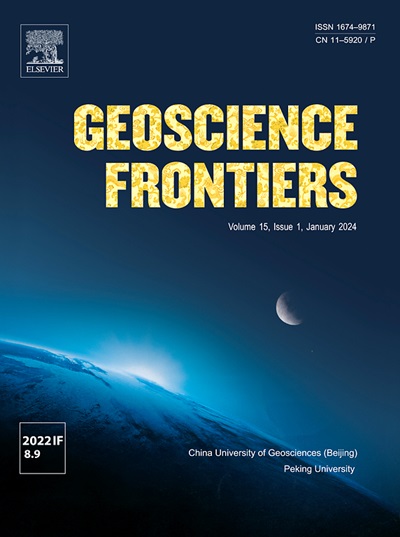40 GPa高压下文石中氦扩散的第一性原理研究
IF 8.9
1区 地球科学
Q1 GEOSCIENCES, MULTIDISCIPLINARY
引用次数: 0
摘要
氦在地幔压力下在碳酸盐中的扩散是理解地幔热化学演化的关键。基于密度泛函理论(DFT)和爬升图像轻推弹性带(CI-NEB)方法,对氦在40 GPa高压下完美文石晶体中的扩散特性进行了第一性原理计算。结果表明,氦的扩散行为受压力、温度和晶粒尺寸的控制。高压作用下,活化能增大,扩散系数明显减小。随着压力从20 GPa增加到40 GPa, Ea[10 0 0]从176.02 kJ/mol增加到278.75 kJ/mol, Ea[0 0 0 1]从195.89 kJ/mol增加到290.43 kJ/mol。在700 K时,40 GPa时的扩散系数比20 GPa时低7个数量级;在1000 K时减小了5个数量级。为了确保至少90%的氦不会丢失,我们综合了从冷却和加热过程中获得的温度,并得出了文石中氦的“稳定温度范围”。结果表明:对于100-2000 μm尺寸的晶体,在0 GPa时稳定温度范围为22 ~ 76℃,在40 GPa时稳定温度范围为641 ~ 872℃;高压下氦在文石中的旅行时间随着压力的增加而迅速增加。我们的计算表明,只要温度在“稳定温度范围”内,氦就可以定量地保留在深部地幔文石中。这些结果对探索地幔的演化和氦在地幔中的储存具有一定的意义。本文章由计算机程序翻译,如有差异,请以英文原文为准。

A first-principles study of helium diffusion in aragonite under high pressure up to 40 GPa
Helium diffusion in carbonates under mantle pressure is crucial for understanding thermal and chemical evolution of mantle. Based on the density functional theory (DFT) and the the climbing image nudged elastic band (CI-NEB) method, we performed first-principles calculations of diffusion characteristics of helium in perfect aragonite crystal under high pressure to 40 GPa. Our results show that He diffusion behaviors are controlled by pressure, temperature and crystal size. The activation energy increases, and the diffusion coefficients decrease significantly under high pressure. Ea[1 0 0] increases from 176.02 kJ/mol to 278.75 kJ/mol, and Ea[0 0 1] increases from 195.89 kJ/mol to 290.43 kJ/mol, with pressure increasing from 20 GPa to 40 GPa. At 700 K, the diffusion coefficients at 40 GPa is 7 orders of magnitude lower than that at 20 GPa; and at 1000 K it decrease 5 orders of magnitude. To ensure that at least 90% helium is not lost, we synthesized the temperature obtained from cooling and heating processes and derive the 'stable temperature range' for helium in aragonite. The obtained results show that the stable temperature range is 22–76 ℃ at 0 GPa and 641–872 °C at 40 GPa, for the crystal of 100–2000 μm size. Besides, the travel time of helium in aragonite under high pressure increases rapidly with pressure increasing. Our calculations indicate that helium can be quantitatively retained in aragonite in the deep mantle as long as the temperature is in the 'stable temperature range'. These results have certain implications for exploring the evolution of mantle and the storage of helium within it.
求助全文
通过发布文献求助,成功后即可免费获取论文全文。
去求助
来源期刊

Geoscience frontiers
Earth and Planetary Sciences-General Earth and Planetary Sciences
CiteScore
17.80
自引率
3.40%
发文量
147
审稿时长
35 days
期刊介绍:
Geoscience Frontiers (GSF) is the Journal of China University of Geosciences (Beijing) and Peking University. It publishes peer-reviewed research articles and reviews in interdisciplinary fields of Earth and Planetary Sciences. GSF covers various research areas including petrology and geochemistry, lithospheric architecture and mantle dynamics, global tectonics, economic geology and fuel exploration, geophysics, stratigraphy and paleontology, environmental and engineering geology, astrogeology, and the nexus of resources-energy-emissions-climate under Sustainable Development Goals. The journal aims to bridge innovative, provocative, and challenging concepts and models in these fields, providing insights on correlations and evolution.
 求助内容:
求助内容: 应助结果提醒方式:
应助结果提醒方式:


